João Rodrigues
Open Sentence Embeddings for Portuguese with the Serafim PT* encoders family
Jul 28, 2024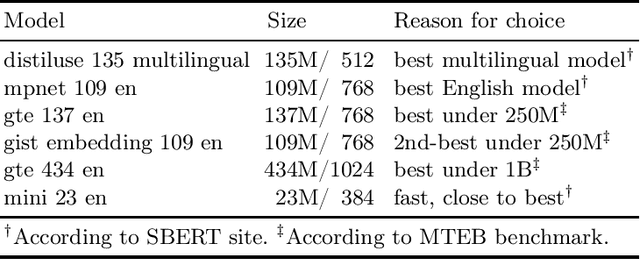

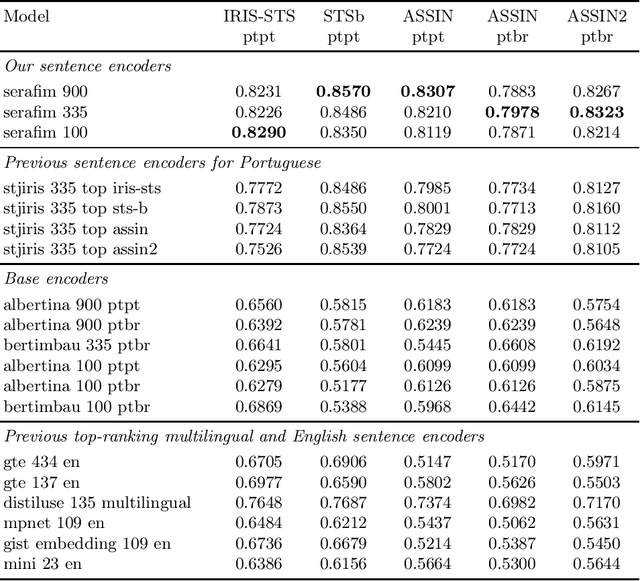
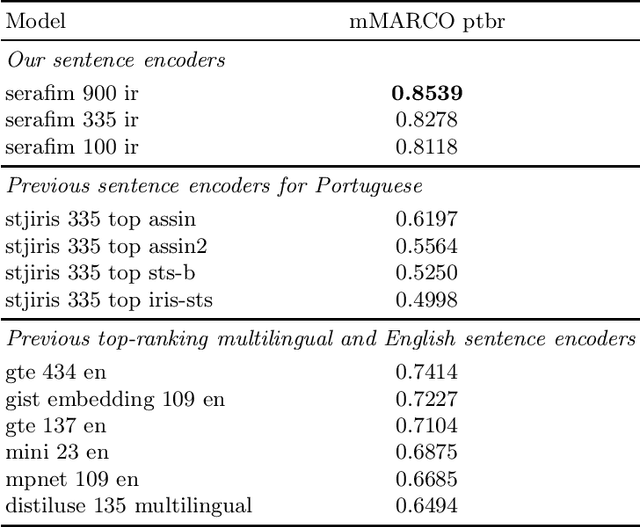
Abstract:Sentence encoder encode the semantics of their input, enabling key downstream applications such as classification, clustering, or retrieval. In this paper, we present Serafim PT*, a family of open-source sentence encoders for Portuguese with various sizes, suited to different hardware/compute budgets. Each model exhibits state-of-the-art performance and is made openly available under a permissive license, allowing its use for both commercial and research purposes. Besides the sentence encoders, this paper contributes a systematic study and lessons learned concerning the selection criteria of learning objectives and parameters that support top-performing encoders.
Meta-prompting Optimized Retrieval-augmented Generation
Jul 04, 2024


Abstract:Retrieval-augmented generation resorts to content retrieved from external sources in order to leverage the performance of large language models in downstream tasks. The excessive volume of retrieved content, the possible dispersion of its parts, or their out of focus range may happen nevertheless to eventually have a detrimental rather than an incremental effect. To mitigate this issue and improve retrieval-augmented generation, we propose a method to refine the retrieved content before it is included in the prompt by resorting to meta-prompting optimization. Put to empirical test with the demanding multi-hop question answering task from the StrategyQA dataset, the evaluation results indicate that this method outperforms a similar retrieval-augmented system but without this method by over 30%.
PORTULAN ExtraGLUE Datasets and Models: Kick-starting a Benchmark for the Neural Processing of Portuguese
Apr 09, 2024Abstract:Leveraging research on the neural modelling of Portuguese, we contribute a collection of datasets for an array of language processing tasks and a corresponding collection of fine-tuned neural language models on these downstream tasks. To align with mainstream benchmarks in the literature, originally developed in English, and to kick start their Portuguese counterparts, the datasets were machine-translated from English with a state-of-the-art translation engine. The resulting PORTULAN ExtraGLUE benchmark is a basis for research on Portuguese whose improvement can be pursued in future work. Similarly, the respective fine-tuned neural language models, developed with a low-rank adaptation approach, are made available as baselines that can stimulate future work on the neural processing of Portuguese. All datasets and models have been developed and are made available for two variants of Portuguese: European and Brazilian.
Fostering the Ecosystem of Open Neural Encoders for Portuguese with Albertina PT* Family
Mar 05, 2024Abstract:To foster the neural encoding of Portuguese, this paper contributes foundation encoder models that represent an expansion of the still very scarce ecosystem of large language models specifically developed for this language that are fully open, in the sense that they are open source and openly distributed for free under an open license for any purpose, thus including research and commercial usages. Like most languages other than English, Portuguese is low-resourced in terms of these foundational language resources, there being the inaugural 900 million parameter Albertina and 335 million Bertimbau. Taking this couple of models as an inaugural set, we present the extension of the ecosystem of state-of-the-art open encoders for Portuguese with a larger, top performance-driven model with 1.5 billion parameters, and a smaller, efficiency-driven model with 100 million parameters. While achieving this primary goal, further results that are relevant for this ecosystem were obtained as well, namely new datasets for Portuguese based on the SuperGLUE benchmark, which we also distribute openly.
Advancing Generative AI for Portuguese with Open Decoder Gervásio PT*
Mar 05, 2024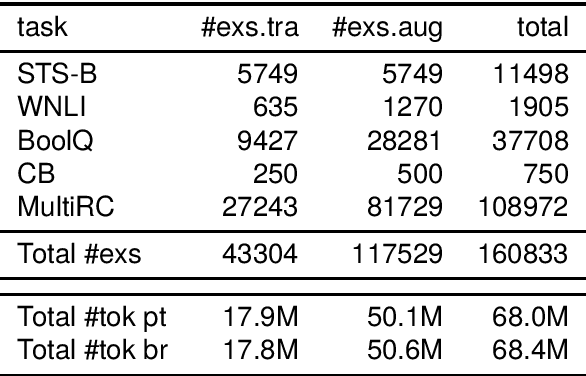
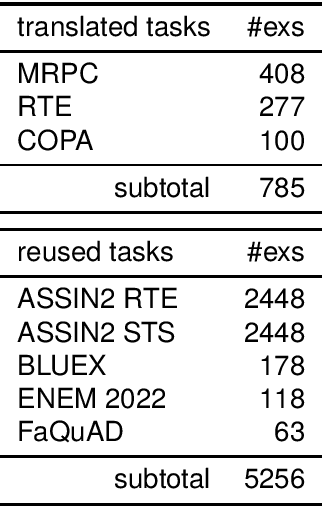
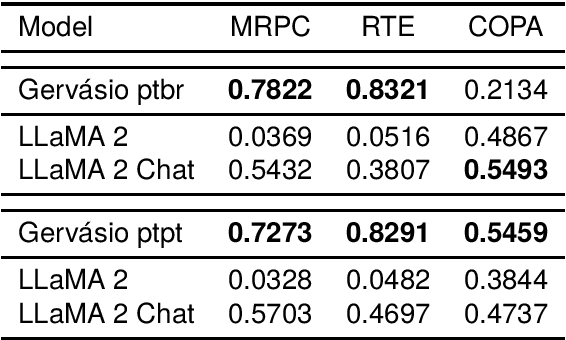
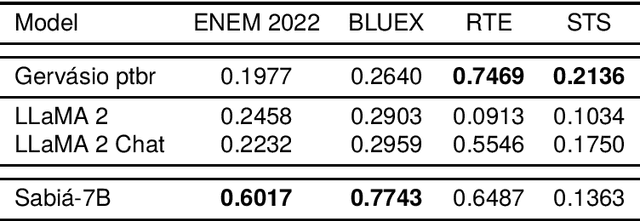
Abstract:To advance the neural decoding of Portuguese, in this paper we present a fully open Transformer-based, instruction-tuned decoder model that sets a new state of the art in this respect. To develop this decoder, which we named Gerv\'asio PT*, a strong LLaMA~2 7B model was used as a starting point, and its further improvement through additional training was done over language resources that include new instruction data sets of Portuguese prepared for this purpose, which are also contributed in this paper. All versions of Gerv\'asio are open source and distributed for free under an open license, including for either research or commercial usage, and can be run on consumer-grade hardware, thus seeking to contribute to the advancement of research and innovation in language technology for Portuguese.
Advancing Neural Encoding of Portuguese with Transformer Albertina PT-*
May 11, 2023Abstract:To advance the neural encoding of Portuguese (PT), and a fortiori the technological preparation of this language for the digital age, we developed a Transformer-based foundation model that sets a new state of the art in this respect for two of its variants, namely European Portuguese from Portugal (PT-PT) and American Portuguese from Brazil (PT-BR). To develop this encoder, which we named Albertina PT-*, a strong model was used as a starting point, DeBERTa, and its pre-training was done over data sets of Portuguese, namely over a data set we gathered for PT-PT and over the brWaC corpus for PT-BR. The performance of Albertina and competing models was assessed by evaluating them on prominent downstream language processing tasks adapted for Portuguese. Both Albertina PT-PT and PT-BR versions are distributed free of charge and under the most permissive license possible and can be run on consumer-grade hardware, thus seeking to contribute to the advancement of research and innovation in language technology for Portuguese.
Transfer Learning of Lexical Semantic Families for Argumentative Discourse Units Identification
Sep 06, 2022



Abstract:Argument mining tasks require an informed range of low to high complexity linguistic phenomena and commonsense knowledge. Previous work has shown that pre-trained language models are highly effective at encoding syntactic and semantic linguistic phenomena when applied with transfer learning techniques and built on different pre-training objectives. It remains an issue of how much the existing pre-trained language models encompass the complexity of argument mining tasks. We rely on experimentation to shed light on how language models obtained from different lexical semantic families leverage the performance of the identification of argumentative discourse units task. Experimental results show that transfer learning techniques are beneficial to the task and that current methods may be insufficient to leverage commonsense knowledge from different lexical semantic families.
Comparative Probing of Lexical Semantics Theories for Cognitive Plausibility and Technological Usefulness
Nov 16, 2020



Abstract:Lexical semantics theories differ in advocating that the meaning of words is represented as an inference graph, a feature mapping or a vector space, thus raising the question: is it the case that one of these approaches is superior to the others in representing lexical semantics appropriately? Or in its non antagonistic counterpart: could there be a unified account of lexical semantics where these approaches seamlessly emerge as (partial) renderings of (different) aspects of a core semantic knowledge base? In this paper, we contribute to these research questions with a number of experiments that systematically probe different lexical semantics theories for their levels of cognitive plausibility and of technological usefulness. The empirical findings obtained from these experiments advance our insight on lexical semantics as the feature-based approach emerges as superior to the other ones, and arguably also move us closer to finding answers to the research questions above.
 Add to Chrome
Add to Chrome Add to Firefox
Add to Firefox Add to Edge
Add to Edge